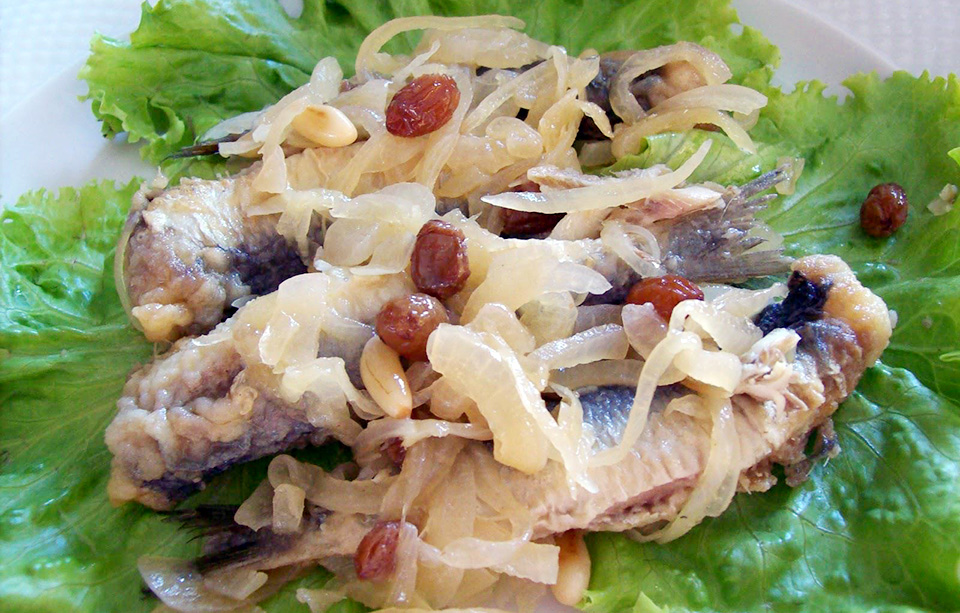Venetian cuisine is known for its variety of dishes and ingredients. The cuisine is based largely on seafood and one of the most representative dish is fish risotto which comes in a variety of forms, the strangest one is the risotto alle seppie with a bright black color that's a result of the cuttlefish being cooked in its own ink.
But the Venice cuisine is famous also for its soups (especially in Caorle area, called brodetto di pesce), recommended where the cephaloped variety of fish concerne cuttlefish, octopus and squid. Among the delicious wines we recommend the Soave, the Pinot, the Cabernet, the Tocai and the Cartizze.
Eat in Venice
Venice has some wonderful restaurants, featuring the cuisine of the Veneto. However it is widely regarded that the restaurants in Venice serve food of a quality and in quantities much lower than anywhere else in Italy. Specialties include polenta, made of corn meal; risotto with cuttlefish ink sauce. Diners should however be aware that for every genuinely wonderful restaurant or trattoria, there's another serving rubbish food at inflated prices, especially in the most touristed streets around San Marco. Rule of thumb: if there's a waiter outside pimping for business, it's probably best avoided.
Near the Rialto bridge there's a row of restaurants with tables by the canal, where you can have the quintessential Venice experience of dining by the canal lights. Although they do have waiters outside bugging you, some have pretty acceptable quality for price.
One of Venice's trademark foods is cuttlefish and its ink. This intense black ink serves as a sauce and ingredient for polenta (corn meal), risotto (rice), and pasta. These dishes are normally indicated by the Italian words "nella seppia" (in cuttlefish), "alla seppia" (in the style of cuttlefish), or "nero di seppia," (black of the cuttlefish). For example Polenta Nella Seppia is fried corn meal with the black ink of a cuttle fish. Despite the intensity in color, the ink has a surprisingly mild taste.
Be careful when the prices are in a weight basis (typically by the "etto", abbreviated "/hg". or 100 g). One dish can easily contain 400g of fish, meat (almost a pound),... 4 times the indicated base price!
Restaurants might offer low prices for food on their menus that they advertise outside the entrance, but they will sometimes compensate this by charging high prices for drinks (which is naturally *not* advertised). €5 for 33 cl of beer is not uncommon.
For fresh fruit (including chilled coconut!) watch out for the street market stalls.
To save money at lunch, eat standing up. Prices can arrive to as much as double as soon as you sit at a table. Minestrone soup is delicious but the server will often offer you a seat as soon as you choose this option. Sitting is worthwhile if you plan on staying a while. Some places will also serve free bread and water for seated patrons, but there is usually also a small charge (€1-3 per person) for "pane e coperto" (cover and bread).
If self-catering, the Rialto food markets are an absolute must for fruit, vegetables and cheese, but most of all for the huge range of seafood, much of it fresh out of the lagoon and still moving! Everything else you will find in the numerous super markets in the city.
Head to the Dorsoduro area of Venice if you want to save a few euros. It has the highest concentration of places where locals, especially students, go to eat. Generally staying away from the main squares will be the cheapest option. If you're willing and able to walk around the town, some back streets offer the best food for the lowest price. Seeing the city from this vantage point is a lot of fun too!
Drink in Venice
Although there are many fantastic bars in Venice, if you're planning a night time "pub crawl" you should plan a few places to visit in advance, otherwise it's very easy to waste an hour wandering aimlessly in search of a watering hole that's actually open (especially midweek).
There are two late-night drinking areas in Venice. Piazza San Marco is not one of them. Although it is very pleasant and there are many people wandering around late. But the actual late night scene is in either Campo Santa Margherita, near the University Ca' Foscari in Dorsoduro; or in Erbaria on the West side of the Rialto Bridge where the main vegetable market is held during the day.
Try a Spritz (with either Campari, Select or Aperol), a typical drink loved by all Venetians that's usually drunk while eating cicheti. You can find it in almost every bar in the city. Price is about €2, more in a touristy place.
If you try the famous Veneto Grappa be careful--it's almost pure alcohol.
The Bellini was invented in Harry's Bar in Venice. It is a mix of white peach juice and Prosecco (the ubiquitous Venetian Champagne-like sparkling wine). Fermented at a low temperature Prosecco develops amylic aromas (fruit drops), though these perhaps mix better with fruit juices than does the more austere Champagne. Classic Bellinis should never be made with Champagne. Although by normal standards expensive, a Bellini in Harry's Bar (€17 for a 1.5 oz drink is obscene) is still much cheaper than on the terraces of similar '5-star' establishments in the city.
Beer in a small pub is about €5 for a pint (birra media).


